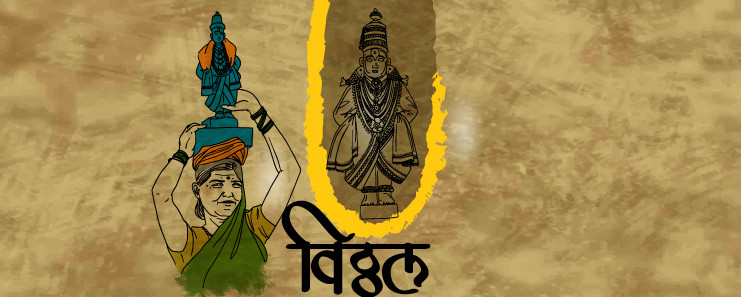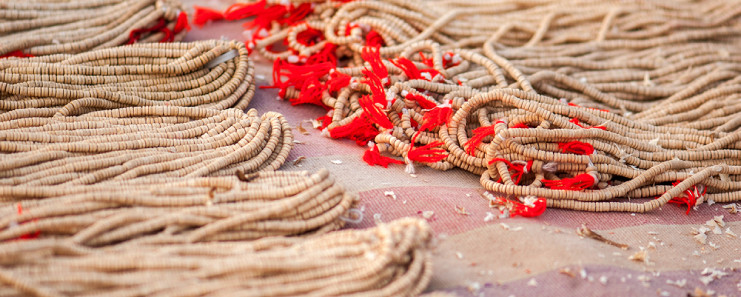Amazing facts about India.
Through the eyes of a seeker
“I felt I had reached heaven,” says Nirmala Bhadane, 63, her eyes twinkling at the memory, while her face shines with a contented smile. “There was no pain, no fatigue, no sense of myself or the other,” she continues, sharing memories from her pilgrims (waris) to Pandharpur.
A devotee of Lord Vitthal, Nirmala is one of the hundreds of devotees who has walked the 224-km pilgrim’s route to Pandharpur. While one would have concerns about the weather, the crowds, fatigue and facilities, a Vitthal devotee doesn’t seem to feel it. “We were in bliss, just singing the name of God. From the time I awoke at 3 am till I slept at 10 pm, there would just be Vitthal’s name and bhajans all around.”

The tradition of the warkaris
Through her pilgrims, Nirmala has joined an illustrious legacy, one that dates back to the 13th century. This tradition is believed to be older than the renowned saints like Sant Tukaram, Sant Namdeo and this pilgrim to Pandharpur is considered to be the penultimate experience for a devotee of Lord Vitthal. The temple of Pandharpur (derived from the word, Pandurang) is dedicated to Lord Krishna, an incarnation of Lord Vishnu.
“Somewhere there exists some inner link between Pandhari and every Maharashtrian. The kind of inner attachment one has for one’s family and ancestors, one feels also for Pandharpur.”
- Durga Bhagwat, Marathi litterateur
Usually devotees organize themselves into dindis or groups and systematically walk the route. Each dindi begins its walk once its name is announced. For someone seeing from afar, the procession will look like a long river of white and red, with some color thrown in. The song of the river would be the chants and voices singing with deep reverence. The white dress and red turbans would usually belong to the warkaris (farmers) of Maharashtra - simple and devout people. Earlier it was the warkaris who would comprise the pilgrim’s route - with people from different classes, backgrounds, and even faiths joining in.
Warkari is the sampradaya that worships Vitthala, who inspired countless devotees like Tukaram, Namdev, Eknath, Jnanadev on the path of devotion. Krishna is worshipped along with His consort Rukmini, as the divine parents of this Cosmos.
The warkaris identify themselves with a series of Marathi religious poets and mystics, spanning around 500 years. These were poet saints who are known for their soulful singing, kirtan.

The warkaris are an old community and travelled across India from Kashi in the North to Rameshwaram in the South. Sarfoji Maharaj of Thanjavur, who is incidentally of Maratha descent, and the great grandson of Shivaji Maharaj, had created endowments for food at the yatri nivas, chatram, along the path for their comfort. The warkaris have a simple philosophy who reject the caste system and believe that singing and chanting is the easiest way to reach moksha.
“There is no class in the dindi,” explains Nirmala, “Everybody is called a mauli (mother) referring to Lord Vitthal, who is called a mauli by all her devotees. Usually I would call a policeman as dada (big brother) or a friend as tai (sister). But in the dindi, we address each other as mauli. It’s as though all of us have given up our identity and we have all assumed the identity of the Lord,” she says.
Lines from a popular bhajan, Maze maher pandhari, beautifully epitomize a devotee’s sentiment:
“Maze maher pandhari, aahe bheevarechya tiri
Pandhari (or Pandharpur, the abode of Vitthala) is my Mother’s Home, it is on the banks of the river Bheema.
Bap aani aai mazi Vitthal Rakhumai”
My Father and Mother are verily My Vitthala and Rakhumai
As Nirmala succinctly put it: "I don’t think of anything or anyone - not even my home. I know they’re taken care of and my focus for the days of the pilgrimage is just the Lord. A warkari does not think in kilometres; his/her destination is Pandharpur.”
Having walked to Pandharpur five times, Nirmala says she only experienced a boil on her foot just once. “The sun beats down very hard on some days, while on others, it’s raining. It’s only faith that makes you walk for 15-20 days. One has to have the iccha shakti (an intention) for the same. If there are any doubts in your mind, then it will get tough,” she cautions, while explaining the daily routine of sleeping in tents, having a quick bath at the place set-up, and meagre meals twice a day.
“Since all the identities become one, we don’t look at each other as a man, woman, stranger, or friend. Everybody is a mauli.”
The wari starts from Dehu and Alandi, halts at various places and reaches Pandharpur on the 11th day of the month of Ashad, also known as Ashadi ekadashi, Padma ekadashi and Devpodhi ekadashi. And the pilgrim happily stands in a queue awaiting the chance to see the famed idol in person. “On one occasion, I stood in the queue for 24 hours. It was such a joy. And on another occasion, the priest gave me a tulsi mala, and some kumkum. I have never experienced such contentment, ever. I reached heaven,” she gushes.
Without experience, it might be hard to imagine a mauli’s mind. Yet it surely is one of love, surrender, and immense faith.

The stories around Ashadi ekadashi
Ashadi ekadashi (or shayana ekadashi) is a very special day for devotees, and one with deep significance. It is the day Lord Vitthal goes into a state of yoga nidra, reclining on the many-headed serpent, shesh naag, at the ksheer sagara (ocean of milk). It is believed that the Lord sleeps for four months and awakens on the Karthik ekadashi, which usually falls in the month of October. There are a lot of different meanings attached to this.
Nirmala explains one of them: The next four months are a busy time for farmers - with planting seeds, nurturing them, and taking care of the harvest. Some of us believe that Lord Vitthal is telling the devotee to work hard, and that He will rest for us. And when the harvest is yielded near Karthik ekadashi, the Lord tells the devotee that all the yield is because of our hard work. He doesn’t take any credit for it. And the devotee, in turn, expresses gratitude for the yield and offers a fistful of the same.
In the Bhavishyapurana, Lord Krishna speaks of the significance of shayana ekadasi to Yudhishtira. Once King Mandhata’s kingdom faced severe drought, and the situation persisted for three years. Then Rishi Angiras advised the king to observe the Ashadi ekadasi vrata. The rains start pouring again and prosperity returned.
The devotion and longing of various saints like Sant Sakubai, Sant Kanhopatra, Sant Savta Mali, Sant Gora Kumbhar, Sant Chokhamela, Sant Kurmadas have defined a devotee’s love for Vithoba. These, and many other miracles and glories of Lord Vitthal are a part of a devotee’s life. Like Sant Janabai, a Marathi religious poet and an ardent devotee, who would keep taking the Lord’s name through the day. Once a neighbour got confused between the dung cakes that she had made and the ones made by Sant Janabai. The revered woman had a very easy solution: Put your ear on any one of them. You will hear Lord Vitthal’s name resonating.

And, of course, the famous story of Pundalik, who was pressing his parents’ feet when Lord Vitthal appeared before him. Not wanting to disturb his parents, Pundalik threw a brick near the Lord’s feet so that the Lord could rest on it. When Pundalik finished his filial duties, he turns his attention to the Lord, and apologized for the delay. The Lord is pleased with Pundalik’s devotion to his parents and grants him a boon. Pundalik, in turn, requests the Lord to stay on earth and bless his devotees. The Lord agrees, and a form of Lord Krishna arose standing on the brick. The temple of Pandharpur was built around that area. Lord Vitthala is also called Vithoba (the one who stood on a brick).
Niraakaar to nirgun ishwar
Asa prakatala asa witewar
Ubhay thhewile haat katiwar
Putala chaitanyaacha
Formless and beyond human perception of personalities, the Lord appears standing on a brick with hands firmly placed on His hips, He is a statue of happiness.
- a stanza from a popular Marathi bhajan - Kanada Raja Pandaricha
In the famous aarti of Vitthala in Marathi, it is said that the Lord has been standing for 28 life spans, waiting for His devotee.
Once a devotee fisherman offered his best catch of two fishes to the Lord of Pandharpur, which the Lord accepted gladly and transformed them into earrings and wore them. This is how Lord Vitthala is seen wearing Makara Kundala or fish earrings.
Devotion that is steadfast & deep
Ashadi ekadashi has immense significance with the culmination of the Pandharpur yatra. Interestingly, Ayurveda prescribes observing the ekadashi fasts (upavasa) as cleansing and detoxification processes. Upavasa (upa-near; vasa - dwell) literally translates into dwelling near the divine. Upavasa on ekadashi days is especially effective owing to the astral positioning of the earth, moon and sun.
The prescribed diets could be many, however, according to Nirmala, it’s an individual’s choice. “The important aspect is to be happy, and in devotion.”
“He has neither form nor name, nor place of abode; He is present wherever we go, Vitthal our mother and sister. He knows neither form nor change of form. He pervades the moving and immovable world. He is neither with nor without attributes, who indeed, can know Him? He will turn to none, says Tuka, who has not faith in him.”
- Sant Tukaram
And happy Nirmala is. Even when she had a dream 12 months ago where a person dressed in white checked her and found a lump in her breast. Nirmala checked herself the next day, and, indeed, found a lump. She alerted her family, and within ten days, a cancerous lump was removed. “It was the Lord who gave me this sign. Otherwise how would I have known?”
Her faith has remained unshaken through her chemotherapy and her good-bad days. This year, her health did not permit her to join the annual dindi. But she visited Pune just to see the procession as it passed through the city. Her prayers intact, and her faith stronger than ever.
Written by: Resha Patel
On a culture trail explores experiences and stories to celebrate the beauty of our diversity.
Special thanks to Nirmala Bhadane for sharing her spiritual journeys and life.
Based on inputs by @bharathgyan. This research team, led by a passionate husband-wife duo - Dr. DK Hari and Dr. Hema Hari, unearth some of India’s untold stories and make them contemporary. You can click here to buy any of their books on Indian civilisation.
We'd like to hear from you. Leave your comments @artofliving
Interact with the author: @BeginsWithMe


































